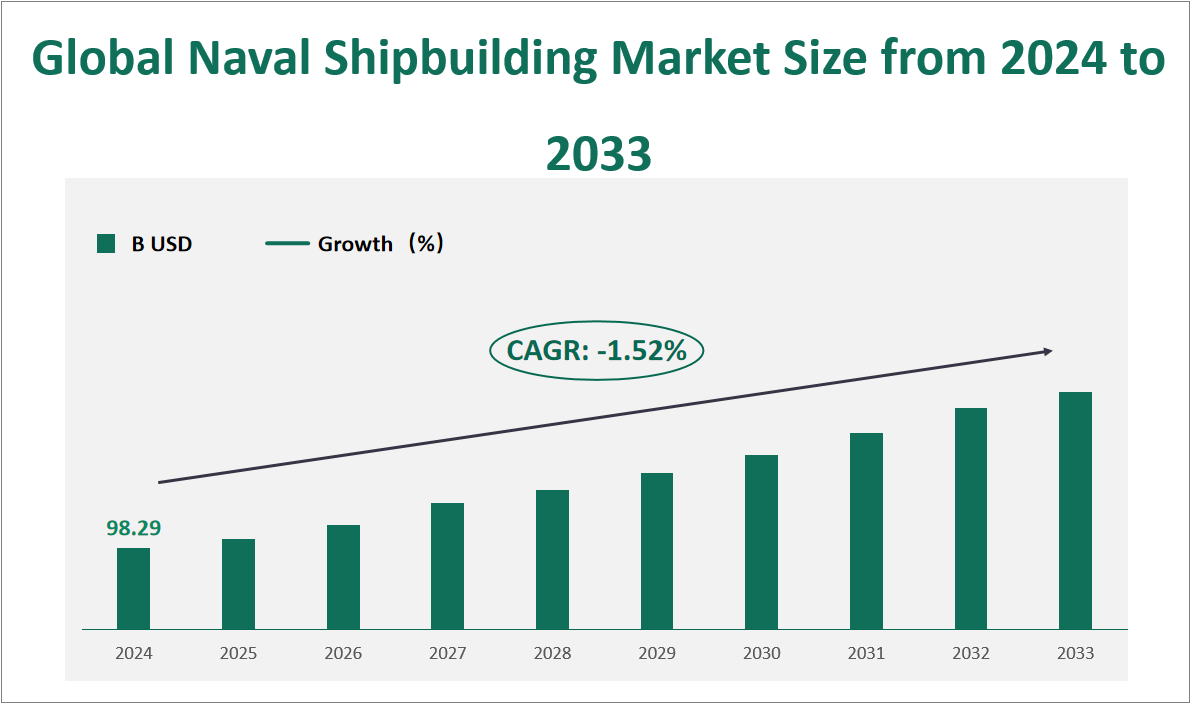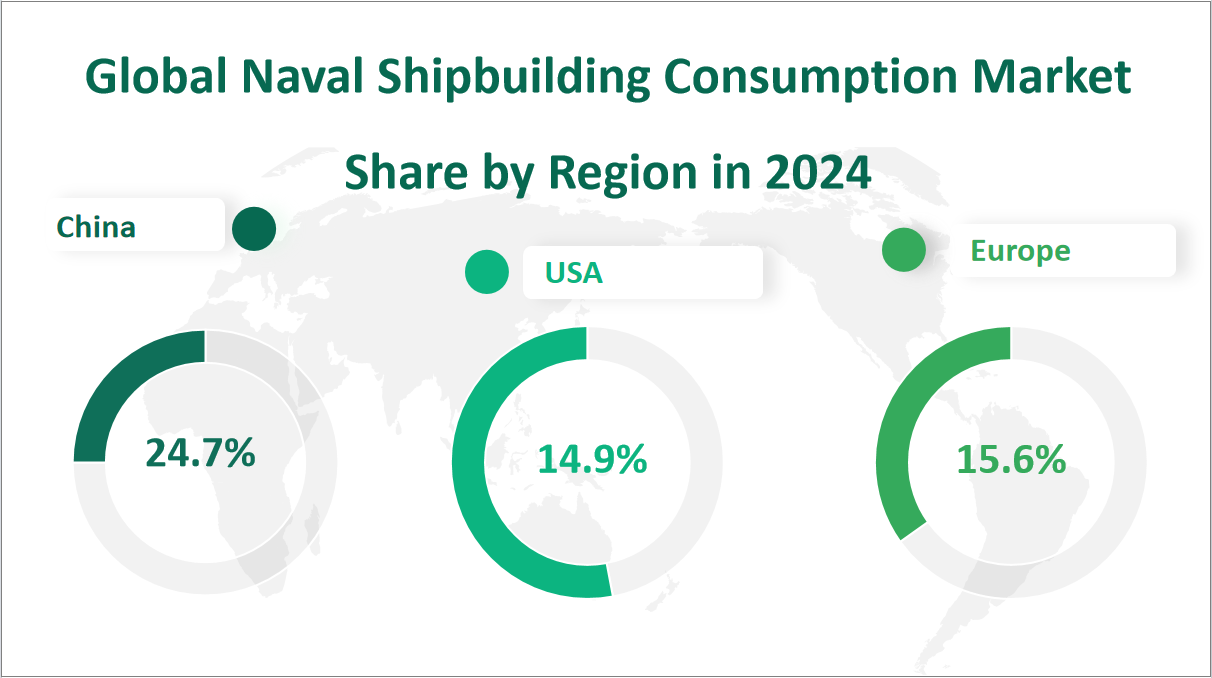1 Global Naval Shipbuilding Market Outlook
The global Naval Shipbuilding market is projected to exhibit substantial growth in the coming years, with a CAGR of -1.52% from 2024 to 2033, reaching a total market size of $98.29 Billion USD in 2024. Naval shipbuilding refers to the specialized construction of ships designed for military and commercial purposes. It involves advanced engineering, materials science, and manufacturing processes to produce vessels capable of operating in various maritime environments. The industry is characterized by high capital investment, long production cycles, and the need for sophisticated technology to meet the demands of modern maritime operations.
Figure Global Naval Shipbuilding Market Size and Growth Rate (2024-2033)

2 Naval Shipbuilding Market Growth Drivers and Constraints
The growth of the naval shipbuilding market is influenced by several driving and limiting factors. Key drivers include the increase in maritime trade, environmental regulations, and global tensions. The rapid industrialization and economic liberalization have led to a significant increase in maritime trade, driving the demand for various types of ships. Additionally, the need for environmentally friendly ships has spurred innovation and investment in green technologies, such as more efficient engines and fuel-saving technologies.
However, the market also faces several challenges. One of the primary limiting factors is the fluctuation in raw material prices, particularly steel, which constitutes a significant portion of the manufacturing cost. This volatility can impact the profitability of shipbuilders. Additionally, the market is highly competitive, with a large number of players vying for market share. This competition has led to a decline in orders and, in some cases, bankruptcies among shipyards.
Another challenge is the long production cycle of naval ships. From the initial inquiry to the completion of the ship, it can take at least two years. This extended period makes the industry susceptible to economic fluctuations and changes in market demand. Moreover, the market is highly fragmented, with no single player dominating the industry. This fragmentation can lead to inefficiencies and increased costs.
3 Naval Shipbuilding Market Innovations and M&A Activities
Technological innovation is a crucial aspect of the naval shipbuilding market. The industry is increasingly adopting advanced technologies such as robotics, which improve efficiency, reduce errors, and perform dangerous tasks. Robotics can significantly shorten production time and enhance overall productivity. Additionally, the development of new materials and advanced manufacturing processes is helping to create lighter, stronger, and more fuel-efficient ships.
Corporate mergers and acquisitions are also shaping the industry. Major players such as Hyundai Heavy Industries Co., Ltd., Daewoo Shipbuilding & Marine Engineering, and China Shipbuilding Industry Corporation have been involved in significant mergers and acquisitions. For example, Hyundai Heavy Industries’ acquisition of Daewoo Shipbuilding & Marine Engineering aimed to consolidate the industry and improve competitiveness. Similarly, the merger of China Shipbuilding Industry Corporation and China State Shipbuilding Corporation was designed to strengthen China’s position in the global market.
These strategic moves are driven by the need to gain economies of scale, improve technological capabilities, and enhance market presence. The consolidation of the industry can lead to increased efficiency and innovation, ultimately benefiting both manufacturers and consumers. However, it also raises concerns about market concentration and potential anti-competitive practices.
In conclusion, the global naval shipbuilding market is a complex and dynamic industry influenced by a variety of factors. While technological advancements and strategic consolidations offer growth opportunities, challenges such as raw material price fluctuations and intense competition must be managed effectively to ensure sustainable development.
4 Global Naval Shipbuilding Market Analysis by Type
In 2024, the global naval shipbuilding market is projected to have a total revenue of 98.29 billion USD. The market share distribution by type is as follows: Cruise ships are expected to generate a revenue of 8.51 billion USD, accounting for 8.66% of the total market share. Ferries will contribute 6.54 billion USD, representing 6.66% of the market. Research vessels are forecasted to bring in 0.95 billion USD, which is 0.97% of the total. Tankers are anticipated to produce 23.68 billion USD, holding a 24.09% market share. Bulk carriers will likely generate 31.70 billion USD, making up 32.25% of the market. Container ships are projected to contribute 14.00 billion USD, or 14.24% of the total revenue. Lastly, other types of ships are expected to bring in 12.90 billion USD, comprising 13.13% of the market share.
Table Global Naval Shipbuilding Market Size and Share by Type in 2024
Type | Market Size in 2024 (B USD) | Market Share in 2024 (%) |
|---|---|---|
Cruise | 8.51 | 8.66% |
Ferry | 6.54 | 6.66% |
Research | 0.95 | 0.97% |
Tankers | 23.68 | 24.09% |
Bulkers | 31.70 | 32.25% |
Containers | 14.00 | 14.24% |
Others | 12.90 | 13.13% |
5 Global Naval Shipbuilding Market Analysis by Application
In 2024, the global Naval Shipbuilding market is forecasted to reach a size of 241.56 million USD, with the following distribution by application: Animal Health is expected to have a market size of 102.82 million USD, accounting for approximately 42.56% of the total market. Human Health is projected to have a market size of 63.47 million USD, representing about 26.28% of the market. Agriculture is anticipated to have a market size of 38.27 million USD, making up around 15.84% of the market. The Food Industry is estimated to have a market size of 27.44 million USD, constituting approximately 11.36% of the total market. The ‘Others’ category is expected to have a market size of 9.57 million USD, which is about 3.96% of the market share.
Table Global Naval Shipbuilding Market Size and Share by Application in 2024
Application | Market Size in 2024 (B USD) | Market Share in 2024 (%) |
|---|---|---|
Navy | 20.19 | 20.54% |
Commercial | 76.21 | 77.54% |
Others | 1.89 | 1.92% |
6 Global Naval Shipbuilding Market Analysis by Region
In 2024, the global naval shipbuilding market’s consumption is forecasted to reach 2,046 thousand units. The consumption market share by region is as follows: The United States is expected to consume 305 thousand units, accounting for 14.9% of the global consumption. Europe will likely consume 319 thousand units, representing 15.6% of the total. China is projected to consume 505 thousand units, making up 24.7% of the market. Japan will consume 170 thousand units, or 8.3% of the total. India is expected to consume 80 thousand units, contributing 3.9% to the global consumption. Southeast Asia will likely consume 115 thousand units, representing 5.6% of the market. Central and South America are forecasted to consume 189 thousand units, accounting for 9.2% of the total. The Middle East and Africa will consume 157 thousand units, making up 7.7% of the market.
Figure Global Naval Shipbuilding Market Share by Region in 2024

7 Top 3 Companies of Global Naval Shipbuilding Market
7.1 Hyundai Heavy Industries Co., Ltd.
Company Introduction and Business Overview:
Hyundai Heavy Industries Co., Ltd. (HHI) is one of the world’s largest shipbuilding companies, headquartered in Ulsan, South Korea. Established in 1971, HHI has a long history of innovation and excellence in the shipbuilding industry. The company operates multiple shipyards and employs advanced technologies to deliver high-quality vessels. HHI is known for its commitment to environmental sustainability and has been at the forefront of developing eco-friendly ships.
Products Offered:
HHI offers a wide range of naval and commercial vessels, including:
Cruise Ships: Designed for luxury travel, these ships are equipped with state-of-the-art amenities and entertainment facilities.
Ferries: These vessels are used for transporting passengers and vehicles across bodies of water, often featuring multiple decks and comfortable seating.
Research Vessels: Built to conduct scientific research at sea, these ships are equipped with advanced laboratories and research equipment.
Tankers: Used for transporting bulk liquids such as oil, LNG, and chemicals, HHI’s tankers are known for their efficiency and safety features.
Bulk Carriers: These ships are designed to transport large quantities of dry bulk goods such as coal, ore, and grain.
Container Ships: HHI builds some of the world’s largest container ships, capable of carrying thousands of TEUs (20-foot equivalent units).
Sales Revenue in the Latest Year:
Hyundai Heavy Industries Co., Ltd. reported a production value of 7.61 billion USD. This figure reflects the company’s strong market position and its ability to deliver high-quality ships across various segments. HHI’s revenue is driven by its diverse product portfolio and its reputation for innovation and reliability.
7.2 Daewoo Shipbuilding & Marine Engineering
Company Introduction and Business Overview:
Daewoo Shipbuilding & Marine Engineering (DSME) is another major player in the global naval shipbuilding market, also based in South Korea. Established in 2000, DSME has quickly risen to prominence through its focus on advanced shipbuilding technologies and high-quality vessels. The company operates multiple shipyards and is known for its expertise in building large and complex ships.
Products Offered:
DSME offers a comprehensive range of naval and commercial vessels, including:
Cruise Ships: These luxury vessels are designed for long-distance travel and feature advanced entertainment and hospitality facilities.
Ferries: DSME’s ferries are known for their efficiency and ability to transport large numbers of passengers and vehicles.
Research Vessels: Equipped with advanced research equipment, these ships are used for scientific exploration and data collection.
Tankers: DSME builds a variety of tankers, including VLCCs (Very Large Crude Carriers) and LNG carriers, known for their efficiency and safety.
Bulk Carriers: These ships are designed to transport large quantities of dry bulk goods and are known for their durability and reliability.
Container Ships: DSME’s container ships are among the largest in the world, capable of carrying thousands of TEUs.
Sales Revenue in the Latest Year:
Daewoo Shipbuilding & Marine Engineering reported a production value of 5.96 billion USD. This figure highlights DSME’s strong market position and its ability to deliver high-quality ships across various segments. The company’s revenue is driven by its focus on innovation and its reputation for building some of the world’s most advanced ships.
7.3 China Shipbuilding Industry Corporation
Company Introduction and Business Overview:
China Shipbuilding Industry Corporation (CSIC) is one of the largest shipbuilding conglomerates in China, established in 1999. Headquartered in Beijing, CSIC operates multiple shipyards and is known for its expertise in building both naval and commercial vessels. The company is a key player in the global shipbuilding market and is committed to delivering high-quality ships through advanced technologies and innovation.
Products Offered:
CSIC offers a diverse range of naval and commercial vessels, including:
Cruise Ships: These luxury vessels are designed for long-distance travel and feature advanced entertainment and hospitality facilities.
Ferries: CSIC’s ferries are known for their efficiency and ability to transport large numbers of passengers and vehicles.
Research Vessels: Equipped with advanced research equipment, these ships are used for scientific exploration and data collection.
Tankers: CSIC builds a variety of tankers, including VLCCs and LNG carriers, known for their efficiency and safety.
Bulk Carriers: These ships are designed to transport large quantities of dry bulk goods and are known for their durability and reliability.
Container Ships: CSIC’s container ships are among the largest in the world, capable of carrying thousands of TEUs.
Sales Revenue in the Latest Year:
China Shipbuilding Industry Corporation reported a production value of 4.41 billion USD. This figure reflects CSIC’s strong market position and its ability to deliver high-quality ships across various segments. The company’s revenue is driven by its focus on innovation and its reputation for building some of the world’s most advanced ships.

